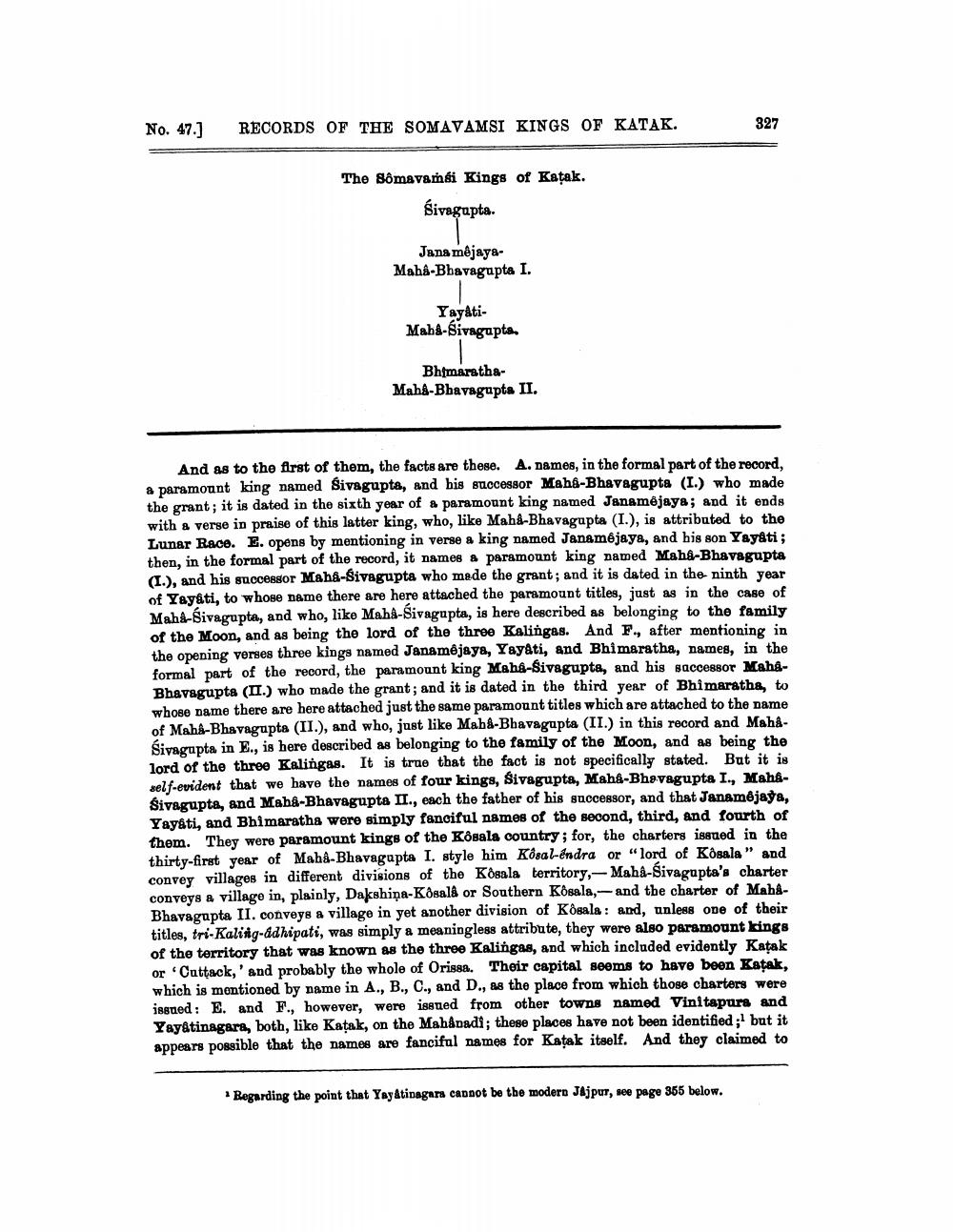________________
No. 47.]
RECORDS OF THE SOMAVAMSI KINGS OF KATAK.
The Sômavamsi Kings of Katak.
Siragupta.
Janamejaya Maha-Bhavagupta I.
YayâtiMahl-Sivagupta.
BhimarathaMaha-Bhavagupta II.
327
And as to the first of them, the facts are these. A. names, in the formal part of the record, a paramount king named Sivagupta, and his successor Maha-Bhavagupta (I.) who made the grant; it is dated in the sixth year of a paramount king named Janamejaya; and it ends. with a verse in praise of this latter king, who, like Maha-Bhavagupta (I.), is attributed to the Lunar Race. E. opens by mentioning in verse a king named Janamejaya, and his son Yayati; then, in the formal part of the record, it names a paramount king named Maha-Bhavagupta (I.), and his successor Maha-Sivagupta who made the grant; and it is dated in the ninth year of Yayati, to whose name there are here attached the paramount titles, just as in the case of Maha-Sivagupta, and who, like Maha-Sivagupta, is here described as belonging to the family of the Moon, and as being the lord of the three Kalingas. And F., after mentioning in the opening verses three kings named Janamêjaya, Yayati, and Bhimaratha, names, in the formal part of the record, the paramount king Maha-Sivagupta, and his successor MahaBhavagupta (II.) who made the grant; and it is dated in the third year of Bhimaratha, to whose name there are here attached just the same paramount titles which are attached to the name of Maha-Bhavagupta (II.), and who, just like Maha-Bhavagupta (II.) in this record and MahaSivagupta in E., is here described as belonging to the family of the Moon, and as being the lord of the three Kalingas. It is true that the fact is not specifically stated. But it is self-evident that we have the names of four kings, Sivagupta, Maha-Bhavagupta I., MahâSivagupta, and Maha-Bhavagupta II., each the father of his successor, and that Janamejaya, Yayati, and Bhimaratha were simply fanciful names of the second, third, and fourth of them. They were paramount kings of the Kôsala country; for, the charters issued in the thirty-first year of Maha-Bhavagupta I. style him Kôsal-éndra or "lord of Kôsala" and convey villages in different divisions of the Kosala territory,-Mahâ-Sivagupta's charter conveys a village in, plainly, Dakshina-Kosala or Southern Kôsala,-and the charter of MahaBhavagupta II. conveys a village in yet another division of Kôsala: and, unless one of their titles, tri-Kaling-ádhipati, was simply a meaningless attribute, they were also paramount kings of the territory that was known as the three Kalingas, and which included evidently Katak or Cuttack,' and probably the whole of Orissa. Their capital seems to have been Katak, which is mentioned by name in A., B., C., and D., as the place from which those charters were issued: E. and F., however, were issued from other towns named Vinitapura and Yayatinagara, both, like Katak, on the Mahanadi; these places have not been identified; but it appears possible that the names are fanciful names for Katak itself. And they claimed to
Begarding the point that Yay&tinagara cannot be the modern Jajpur, see page 355 below.




